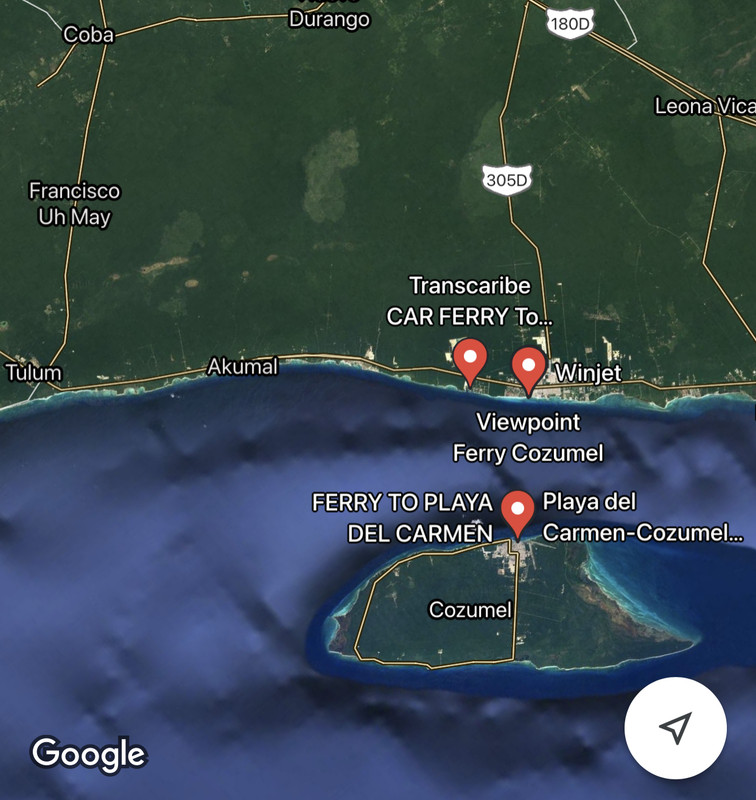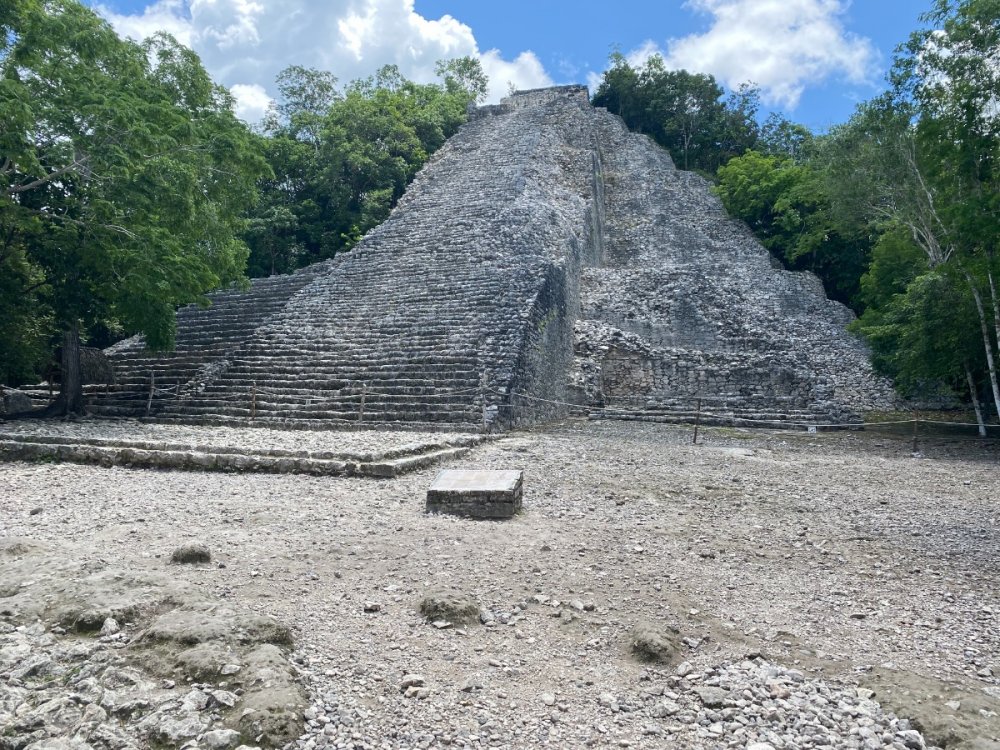Coba Mayan Ruins
The ancient city of Coba once covered a 70 kilometer area and was home to over 55,000 Mayans. The archaeological zone is only about two kilometers. It consists of several areas connected by the Mayan highway and includes the second tallest temple in the Mayan world.
Coba is located approximately 30 miles northwest of Tulum. You can access it by taxi cab, collectivo, bus, or by booking a private tour.

To get to Coba you need to first get to Tulum. If you are coming from Cozumel, you will need to take a 45 minute ferry ride to Playa Del Carmen. Ferries leave every hour. A roundtrip ticket costs $25 per adult and $17 per child. You can get more information on the ferry here.



Once you arrive in Playa Del Carmen, you’re going to be in their major tourist shopping district. If you want to go to Tulum or Coba by taxi cab, it will be easy to catch one in this area.
The cheapest form of transportation to Tulum is a shared van called a collectivo. A collectivo making the one hour drive from Playa Del Carmen to Tulum should cost no more than 100 pesos or $5 per person.
The collectivo station is under an overpass 3/4 of a mile from the ferry terminal. You could take a taxi to the station or it’s a straight shot if you want to walk it. You may even run into a collectivo along the way that will pick you up if you flag them down.


The downside to getting into a collectivo at the station is they will make every effort to fill it up before you leave. It shouldn’t take more than a few minutes to fill up at this station. Most people on the collectivo will not be making the full trip. It won’t be long before they start dropping people off and the ride becomes more comfortable. They could always pick up some people along the way but it’s unlikely to be full.

If you are traveling from a resort between Playa and Tulum, you can flag down a collectivo on the street. They are all over the place. It won’t take more than a minute to find one.

If you are looking to take a collectivo from Tulum to Coba, you can have the driver drop you off at one that is getting ready to head in that direction.
A collectivo to Coba would cost about 50 pesos or no more than $3 per person. This collectivo will not leave until it has at least six people and there aren’t a lot of people around here waiting to go to Coba. If you have six in your group, you’re golden. Otherwise you may ask the driver if you can pay additional to leave with fewer people.

If you don’t want to wait for a collectivo you can ask your collectivo driver to drop you off at the bus station down the street.
There will also be taxi cabs out in front of the bus station if you want to use that option. They quoted me $50 for a one-way trip to Coba.

A one way bus ticket to Coba cost me 55 pesos or about $2.90.

The bus is nice, comfortable, and not too crowded.

They have air vents and USB connections.

Once you arrive in Coba It’s just a short walk to the ruins.

Just take a left at the sign and it will take you to the entrance.

Coba means “stirred waters” which is believed to be due to the lagoons that surround it.

This is the entrance.

The cost of a ticket is 80 pesos which is about $4. There are a bunch of tour guides wanting you to hire them for $15. If I could go back I would’ve rented a bicycle which I heard was just a few dollars. I didn’t realize how big this place was until I got into it. If you don’t want to or can’t walk or ride a bicycle, you can hire a pedicab driver for $15.


As I was saying this place is huge. The entire thing was 70 kilometers. 55,000 Mayans lived in the area. The portion we’re looking at is just a couple kilometers, which is still larger than any ruins I’ve visited.

This is the first grouping which is the Coba Group.

The first grouping includes the second tallest temple in Coba. This is known as La Iglesia (The Church). We talked about Stelas during my trip to Tulum. Coba has many Stelas mostly in front of the structures like this one.




This is very similar to the entrance and exit to Tulum.



The Mayan ball court is easy for me to recognize. It’s very similar to the one I saw at Lamanai in Belize.






This is when I started to understand why they have bicycle rentals and pedicab drivers at the front.

This is the first time I have seen Mayan ruins this spread out. I have already walked a good distance. According to this I have to walk 1KM to the left and 1KM back. Then I have to walk 1KM straight and 1KM back. Then back to the entrance which is probably another KM. If you get to this point on foot you will really wish you rented transportation.

I went left first which will take us to the main temple.
This is the King’s Palace. We will pass it several more times.




This is another Mayan ball court.
The game they played on these courts is believed to be the world’s first organized team sport. Teams of 2-4 players would try to bounce a nine pound rubber ball, which was made from tree sap, to the other team’s side without using their hands. They most frequently used their hips. They would hit the ball with their hip, many times throwing themselves down on that hard surface which had a smooth limestone finish at the time. When the ball rolled back down another player would hit it back up with their hip.
Once they got the ball bouncing they could try to bounce it through the hoop. It is said that the hoop wasn’t on the original ball courts and bouncing it through the hoop, which was added later, would result in an automatic win. Most games were won with points which were scored when a team let the ball bounce too many times or go out of bounds. The scoring seems similar to that of tennis. It has been said that some players were killed getting hit in the head with a ball. The Mayan ball game, not tennis.

This is the ball court from a distance.

This is Xaibe (crossroads). It is believed to have been used as a watch tower because it is near the intersection of four major roads.

This is the back side of Xaibe.

Near the main temple is the only place you can purchase drinks other than by the entrance.

We are in the Nohoch Mul group.

This is the main temple Ixmoja which is also known as the Nohoch Mul pyramid. Nochoch Mul means Great Mound. It is the tallest temple in Coba and the second tallest Mayan temple in existence. At 138 feet, it is 30 feet taller than the High Temple I climbed in Belize.

You used to be able to climb this temple but for now it is roped off. Since this site was closed for over five months, archaeologists are going to have to clean and inspect all 120 steps before people are allowed to climb again.



This is the King’s Palace again on the way out. If you walk back behind it would shortcut you to the next grouping.

At the fork in the road there were a couple of available pedicab drivers so I fixed my earlier mistake and hired one. If you read this, you probably already have your own transportation by now.

We are going to head to the Macanxoc group next then Pinturas on the way out.


We came to a part he said was the actual Mayan highway. Mayans traveled at night and their highways were made of white limestone which was lit up at night by the moonlight. Here is a video of part of it.
This is the Macanxoc group. The pedicab driver dropped me off and had me walk back into the woods to get to these ruins.
This group includes eight stelas and 18 alters. Stela 1 has dates inscribed on it including the 21st of December 2012 which can be interpreted as the end of times or the beginning of a new Mayan era.
















I got turned around and forgot which direction I came in from. I was the only person around and there was no clear exit. Finally I saw another ruin through the trees and walked over to it. Then some other people came and I just went back they way they came from and found my guide. It is very easy to get lost back here.

That’s my driver in the blue shirt on the left. He’s wondering what took me so long.

The last part we’re going to is called paintings.


This is the Pyramid of the Frescoes which was built in the later years of the city.

The Pyramid of the Frescoes had paintings in the top room.

If we zoom in you can still see Mayan colors up top.









This is the King’s Palace again. Paintings is right behind. That piece of knowledge can save you some walking if you’re ever here.

Coba eventually lost a regional power struggle with Chichen Iza but wasn’t completely vacated until the Spanish conquered the area.

My driver wanted $5 for the partial ride. I gave him $10. It turns out you don’t pay them direct you pay the cashier. So I gave him 5 and the cashier 5. They gave me this receipt.

Back at the entrance.

They have some shopping outside.

They also have a bar and restaurant outside. The bus station is a short walk. I’m told the bus is 2nd class so it could be later than scheduled. I inquired about a taxi cab and was able to secure one to take me to Tulum for $30.

I inquired about a taxi cab and was able to secure one to Tulum for $30.

If you want to take a collectivo back to Playa or to a resort, you can have the cab driver drop you off at the collectivo station.

If you are came from Cozumel you can catch your ferry back to the island when you arrive back in Playa Del Carmen.





















